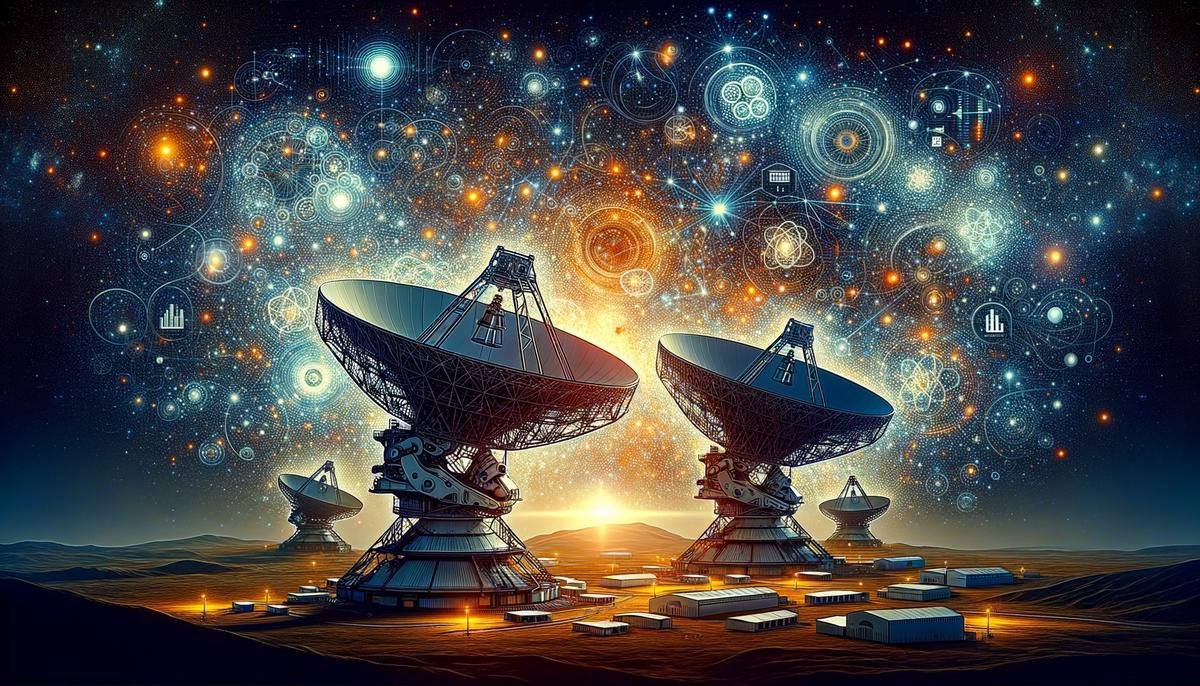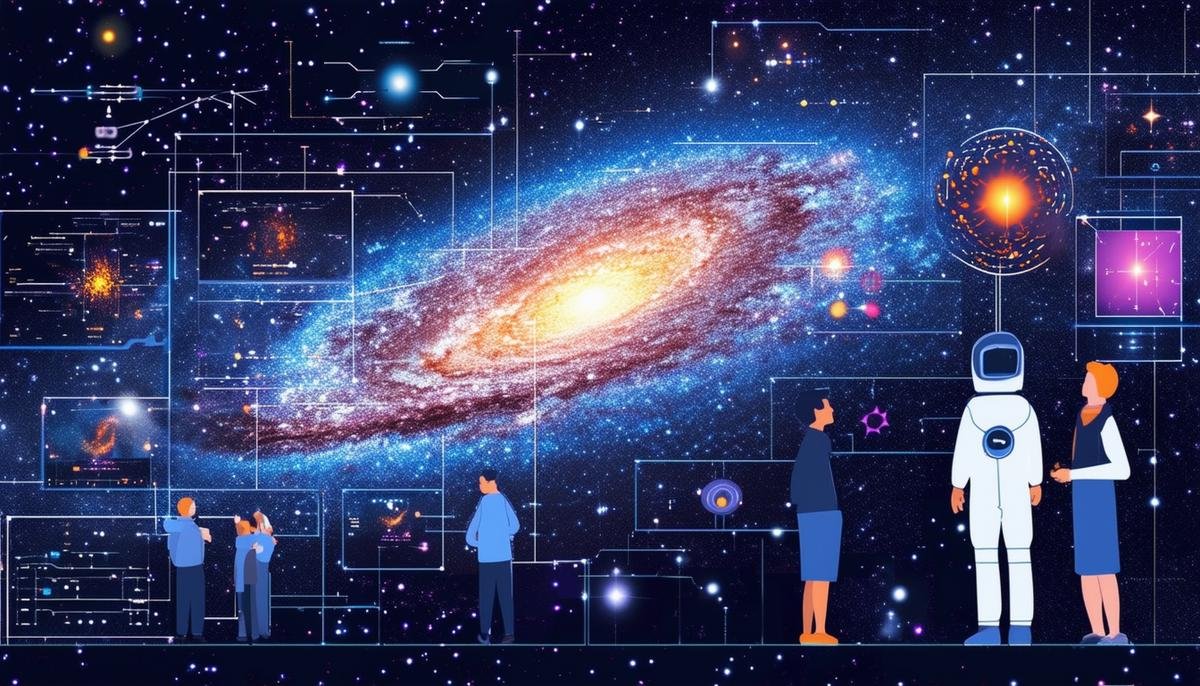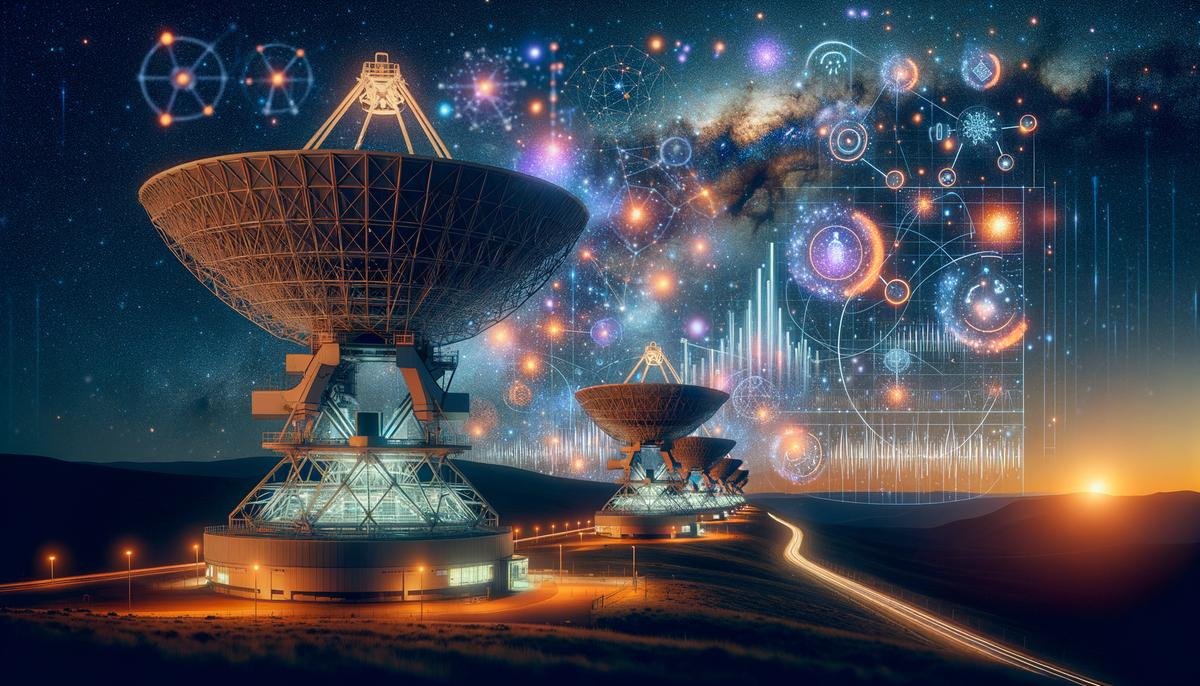The Astrophysics Data Lab, established in 2020, has taken significant strides in leveraging machine learning to enhance our understanding of cosmic phenomena. By utilizing vast datasets and innovative techniques, the lab supports astronomers in making groundbreaking discoveries.
Astrophysics Data Lab and Machine Learning
The lab’s core tasks include building frameworks that translate machine learning methods to address astrophysics problems. By devising innovative ways of data utilization, the lab supports astronomers in adopting data-driven practices. One spotlight effort involves developing deep learning techniques and Bayesian object detection to identify and characterize stars and celestial objects in images.
Consider the construction of object detection algorithms, which can determine whether a source in an image is a star. On the Galactic center, stars can overlap in brightness and projection. The lab, through deep learning models, like Generative Adversarial Networks (GANs), addresses these intricacies. GANs consist of dual neural networks, one generating objects and another discerning real from fake, making it a popular method in self-driving tech and astronomy alike.
Machine learning’s power in time reduction is immense. Neural networks can drastically shorten the analysis time of gravitational lensing images. Previously, processes taking weeks now perform in seconds. This automation is pivotal for future sky surveys that produce extensive data volumes.
AstroML, an integral tool here, is a Python library customized for machine learning in astronomy. Built on established libraries like numpy and scipy, AstroML provides streamlined access to common tools used in the analysis. Researchers can reach out on platforms like GitHub to contribute or critique, fostering a broad scientific community.
Data from powerful telescopes like the James Webb Space Telescope and the forthcoming Square Kilometre Array (SKA) propels this field forward. These projects produce data at unprecedented rates, requiring efficient algorithms for parsing and interpreting. Machine learning models can handle this data surplus, unlocking potential insights into the birth and death of stars.
The Lab’s approach is collaborative. Engaging with industry partners like Closer helps harness advanced data science techniques for space research. Algorithms developed with Closer attained fourfold predictions of radio galaxies compared to conventional methods.
To integrate these cutting-edge methods, the lab runs a Machine Learning Reading Group. This group dives into machine learning and its connections to statistical tools in astronomy. Members discuss principles and methods from text examples and algorithms, ensuring astronomers stay abreast of current techniques.
The lab’s future looks promising, with extensive practical applications and a support system advancing the field. Machine learning opens new frontiers in astronomical research and streamlines processes that previously bogged down progress. By continuously evolving and applying these data-driven techniques, the Astrophysics Data Lab is set to transform our understanding of the cosmos.
Object Detection in Astronomy
Crowded astronomical images present unique challenges, particularly when various objects overlap or differ widely in brightness. Object detection in this context isn’t merely recognizing stars but accurately distinguishing them from other celestial entities and noise. Traditional approaches fell short in scenarios involving dense star fields, such as the Galactic center, where stars can appear deceptively brighter or fainter due to projection effects.
The introduction of deep learning and Bayesian object detection methods has revolutionized this aspect of astronomy. Deep learning models, leveraging immense datasets, can identify and separate stars from their crowded backdrops with remarkable precision. One notable technique involves using convolutional neural networks (CNNs) designed to parse images and identify patterns that signify stellar objects.
Deep learning models excel at synthesizing complex data profiles, such as reconstructing the point-spread function (PSF) across varying image segments in adaptive optics imaging. The PSF, which depicts how a point source (like a star) appears on an image, can fluctuate due to atmospheric turbulence and instrumental factors. By understanding these variations, CNNs can better resolve individual stars in crowded fields, enhancing both detection and characterization accuracy.
Advancements involve Bayesian object detection, which leverages probability models to distinguish celestial objects. Bayesian methods statistically infer the likelihood of an object’s properties, improving the reliability of identifications made by neural networks. This probabilistic approach is especially useful in images where objects overlap or display wide brightness ranges, offering a nuanced analysis customized to each unique observation.
Practical applications of these advancements are profound. In the upcoming Legacy Survey of Space and Time (LSST), scheduled to revolutionize our galactic observations, object detection methods will be crucial. Detecting supernovae, mapping dark matter through gravitational lensing, and cataloging billions of stars and galaxies efficiently require scalable machine learning solutions.1 By refining these methods, astronomers are poised to make unprecedented discoveries about the universe’s fundamental nature.
In conclusion, the quest for precise object detection in crowded astronomical images underscores the transformative impact of advanced machine learning techniques. Deep learning and Bayesian methods enhance our capability to analyze intricate celestial data, revealing insights that were previously out of reach. As we push the boundaries of technology and data science, the fields of astronomy and astrophysics are entering an era of accelerated discovery and deeper cosmic understanding.

Machine Learning Techniques and Tools
One of the central machine learning techniques employed in astronomy is the neural network, a model inspired by the human brain. Neural networks have seen a surge in popularity due to their adaptability and efficiency in handling large sets of data, making them indispensable for tasks such as classification and pattern recognition in astronomical datasets. The extensive use of convolutional neural networks (CNNs) stands out, particularly in image recognition applications. These networks can discern complex patterns within data, enabling astronomers to detect celestial objects with unprecedented accuracy.
Generative Adversarial Networks (GANs) also play a pivotal role in astronomical image processing. GANs consist of two neural networks — a generator and a discriminator — pitted against each other to improve data generation and cleaning. When applied to astronomical images, this method can effectively reduce noise, a common issue caused by atmospheric disturbances or instrumental artifacts. GANs can generate cleaner images from raw telescope data, significantly boosting the quality of information extracted from ground-based observations.
In analyzing gravitational lensing, neural networks have excelled in simplifying what was once a highly labor-intensive process. Traditionally, astronomers would painstakingly compare images of lensed galaxies against large libraries of simulated models, a method both slow and inefficient. The advent of deep learning approaches, particularly neural networks, has automated and streamlined this procedure. A neural network can now analyze and predict gravitational lensing patterns in mere seconds, identifying dark matter distributions and other cosmic phenomena that were previously elusive.
AstroML, an integral toolkit in this domain, offers a suite of machine learning and statistical algorithms specifically designed for astronomy. Built on top of widely utilized libraries like numpy, scipy, and scikit-learn, AstroML provides a user-friendly interface for researchers. AstroML’s capabilities span various tasks from simple data transformations to complex modeling techniques, making it a one-stop solution for implementing machine learning in astronomical research.2
These techniques are steadily being refined and integrated into large-scale projects such as the Legacy Survey of Space and Time (LSST). The LSST initiative will benefit vastly from advanced machine learning algorithms to catalog billions of astronomical objects, map dark matter, and study transient phenomena like supernovae. Object detection within this vast dataset will demand the scalability and efficiency provided by models like CNNs and GANs. By equipping astronomers with these tools, the LSST can maximize observational output and accelerate cosmic discoveries.
In summary, the implementation of machine learning techniques and tools such as neural networks, GANs, and AstroML, is revolutionizing the landscape of astronomical research. These innovations enhance the efficiency and accuracy of data analysis and facilitate the exploration of uncharted territories in our universe. By continually evolving these methodologies, the astronomical community is poised to make groundbreaking discoveries, further unraveling the mysteries of the cosmos.
Case Studies: JWST and LSST
The James Webb Space Telescope (JWST) and the Large Synoptic Survey Telescope (LSST) represent two monumental strides in our quest to understand the universe. Both telescopes produce immense volumes of data, challenging traditional data analysis methods and making machine learning an indispensable tool.
Researchers at Penn State University have harnessed machine learning to transform interpretation and management of data from these advanced observatories. The JWST, with its ability to capture high-resolution images of deep space, generates approximately 235 gigabytes of science data daily.3 This monumental influx of information requires sophisticated algorithms to sift through and extract meaningful insights.
Joel Leja and V. Ashley Villar, assistant professors of astronomy and astrophysics at Penn State, have been pivotal in integrating machine learning techniques to handle the deluge of astronomical data. Leja emphasizes the efficiency machine learning offers, likening traditional data processing to laboriously mapping every road between Los Angeles and San Francisco, whereas machine learning harnesses vast datasets to find the fastest route instantly. This analogy underscores the paradigm shift in data analysis speed and accuracy brought by machine learning.
- Machine learning models, particularly convolutional neural networks (CNNs), aid in deciphering complex patterns within the data and enable researchers to detect and categorize celestial objects swiftly.
- Analyzing galaxy images using traditional methods might take several years with supercomputer resources. In contrast, machine learning reduces this down to mere hours, even on conventional laptops, as evidenced by Leja’s transformative experiences.
The LSST, on the other hand, promises even more data than the JWST, with projections of about 15 terabytes each night over ten years.4 This next-generation survey’s dataset demands equally analytical techniques. To meet this need, researchers employ machine learning algorithms to efficiently and accurately map galaxy distributions, study transient phenomena, and detect signatures of dark matter.
Villar’s research focuses on star explosions within the LSST data. Using traditional methods, understanding a galaxy’s history to investigate star explosions would be a mammoth task. However, machine learning slices through this complexity, enabling rapid, reliable analysis for each galaxy. This highlights how machine learning is solving current challenges and opening new avenues for astronomical inquiry.
Penn State’s use of the ICDS Roar supercomputer illustrates the institutional support necessary for these advancements. By providing computational muscle and expertise, ICDS enables the efficient training and testing of machine learning models. This support is essential for scaling up these techniques to meet the demands of LSST and JWST data workloads.
In summary, the combination of JWST and LSST data with machine learning techniques catalyzes a profound shift in astronomical research. Researchers at institutions like Penn State are at the forefront of this innovation, pushing the boundaries of what is possible by leveraging the speed, efficiency, and accuracy of machine learning algorithms. As these methods refine, they promise to unlock new cosmic phenomena, paving the way for more profound discoveries about the universe.

Galaxy Zoo and Citizen Science
The Galaxy Zoo project, launched in 2007 by Kevin Schawinski and Chris Lintott, demonstrates the power of citizen science in astronomical research. Faced with the task of classifying 900,000 galaxy images from the Sloan Digital Sky Survey, Schawinski and Lintott enlisted public participation. Citizen scientists helped classify galaxies as elliptical or spiral, completing the project in just two years.
However, the success of Galaxy Zoo also highlighted the limitations of relying solely on human eyes for classification, especially as technological advancements enable telescopes to capture exponentially more data. This is where machine learning plays a pivotal role, augmenting the efforts of citizen scientists and enhancing the efficiency and accuracy of data analysis.
Machine learning algorithms, particularly neural networks, have become integral in processing vast astronomical datasets that volunteers alone cannot keep up with. These algorithms excel in recognizing patterns and structures within data, often with greater speed and precision than human classifiers.
The hybrid model of combining human and machine efforts is particularly effective. Machine learning algorithms first process and pre-classify large datasets, filtering out simpler cases for immediate use and flagging more complex or ambiguous examples for human review. This synergy allows for the best of both worlds: the nuanced judgment of human classifiers and the computational power of machine learning.
Subsequent iterations of the Galaxy Zoo project have embraced this blend of machine learning and human participation. As neural networks classify vast swathes of data quickly, they enable volunteers to focus on verifying and fine-tuning the results. This collaborative framework optimizes data analysis and enhances the educational and engagement aspects of citizen science.
Machine learning can discern previously unseen patterns and classifications, potentially uncovering new types of galaxies or cosmic phenomena that had not been theorized. This capability highlights the importance of machine learning as an exploratory tool in astrophysics.
The educational impact of Galaxy Zoo and similar projects is significant. By involving citizens directly in scientific research, these initiatives demystify science and foster a culture of curiosity and learning. Participants gain a hands-on understanding of astronomical techniques and contribute to genuine scientific discoveries, often driven by the insights facilitated by machine learning.
The integration of machine learning in citizen science is not without its challenges. Ensuring the accuracy and reliability of machine-generated classifications requires careful training and validation against known datasets. Maintaining engagement among volunteers necessitates a balance between automated processes and tasks that are sufficiently challenging and rewarding for human participants.
As projects like Galaxy Zoo continue to evolve, they are likely to become increasingly sophisticated in their use of AI-driven methodologies. This evolution will enable the processing of ever-larger datasets, uncovering more detailed and nuanced cosmic insights.
As telescopes become more advanced and data generation continues to accelerate, the blend of machine learning and citizen science will be crucial in managing and interpreting this data deluge. Projects like the Large Synoptic Survey Telescope (LSST) and the Square Kilometre Array (SKA) will benefit immensely from this collaborative approach, promising to deepen our understanding of the universe.
The Galaxy Zoo project epitomizes the potential of combining human ingenuity with advanced machine learning techniques. By leveraging the strengths of both citizen scientists and AI, astronomy is set to enter a new era of discovery, marked by unprecedented data analysis capabilities and collaborative scientific inquiry. This integration advances our cosmic knowledge and democratizes the process of scientific discovery, inviting the global public to participate in uncovering the secrets of the universe.

Future Prospects and Challenges
As we look to the future of machine learning in astronomy, the horizon is filled with promising projects and considerable challenges. Upcoming initiatives like the Square Kilometre Array (SKA) and the Evolutionary Map of the Universe (EMU) present opportunities to deepen our cosmic understanding through advanced machine learning techniques.
The SKA, slated for completion in the mid-2020s, is poised to be the world’s largest radio telescope. With its vast array of 2000 radio dishes and millions of low-frequency antennas, the SKA will produce data on an unprecedented scale. Handling this data deluge requires scalable machine learning algorithms capable of managing over 1 exabyte of data per day1. This challenge calls for cutting-edge machine learning strategies that can process this immense data volume rapidly and extract meaningful information.
Parallel to this, the EMU project, utilizing the ASKAP radio telescope in Australia, will map the southern sky comprehensively, identifying and cataloging billions of celestial objects. The EMU aims to uncover radio galaxies in unprecedented detail, utilizing machine learning algorithms to sift through billions of detections and isolate significant discoveries from the noise. As these projects come online, the role of machine learning in astronomy will become even more critical.
Despite these exciting prospects, significant challenges remain. One of the most profound is data bias. Machine learning models require large volumes of labeled data to train effectively, but the available datasets often reflect human biases or limitations in our current understanding. To mitigate such biases, it is essential to continually refine and expand training datasets, incorporating diverse and comprehensive examples that reflect a broader spectrum of cosmic phenomena.
Another major obstacle is the sheer volume of unprocessed and unlabeled data. Large-scale projects generate astronomical amounts of information that must be accurately labeled and curated before they can contribute meaningfully to machine learning models. This requirement presents a significant bottleneck, as manual labeling is incredibly time-consuming and computationally taxing.
Citizen science initiatives, such as those pioneered by Galaxy Zoo, can play a pivotal role here by enlisting public help in data labeling, thus speeding up the dataset expansion process. Integrating machine learning to pre-label data, followed by human verification, can further optimize efficiency.
Moreover, transparency and interpretability in machine learning models remain crucial considerations. Neural networks and other complex algorithms often function as “black boxes”; they provide answers without a straightforward rationale behind their decision-making processes. Scientists’ reluctance to fully trust these models stems from this opacity, especially when making critical scientific inferences. Therefore, developing methods for more interpretable and explainable AI is paramount.
Despite these challenges, the integration of machine learning in astronomy holds transformative potential. The continuous progress in computational power, coupled with collaborative efforts between machine learning experts and astrophysicists, will push the frontiers of what we can achieve. As machine learning models become more sophisticated and as we address the challenges of data bias and interpretability, the future of astronomy will be marked by more profound and rapid discoveries, illuminating the universe’s secrets.

The integration of machine learning in astronomy is set to revolutionize our understanding of the cosmos. As we continue to refine these techniques and apply them to large-scale projects like the Square Kilometre Array and the Evolutionary Map of the Universe, we stand on the brink of unprecedented discoveries. The synergy between human ingenuity and artificial intelligence promises to unravel the mysteries of the universe, propelling astronomy into a new era of groundbreaking insights and cosmic revelations.




